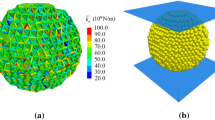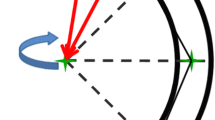Abstract
In this paper, computational aspects of crushing/comminution of granular materials are addressed. For crushing, maximum tensile stress-based criterion is used. Crushing model in discrete element method (DEM) is prone to problems of mass conservation and reduction in critical time step. The first problem is addressed by using an iterative scheme which, depending on geometric voids, recovers mass of a particle. In addition, a global–local framework for DEM problem is proposed which tends to alleviate the local unstable motion of particles and increases the computational efficiency.























Similar content being viewed by others
References
McDowell G, Harireche O (2002) Discrete element modelling of soil particle fracture. Geotech-Lond 52(2):131–136
Cheng Y, Nakata Y, Bolton M (2003) Discrete element simulation of crushable soil. Geotechnique 53(7):633–642
Bolton M, Nakata Y, Cheng Y (2008) Micro-and macro-mechanical behaviour of dem crushable materials. Géotechnique 58(6):471–480
Ben-Nun O, Einav I (2008) A refined DEM study of grain size reduction in uniaxial compression. In: The 12th international conference of international association for computer methods and advances in geomechanics (IACMAG), Goa, India, pp 702–708
Marketos G, Bolton MD (2009) Compaction bands simulated in discrete element models. J Struct Geol 31(5):479–490
Cundall PA, Strack OD (1979) A discrete numerical model for granular assemblies. Geotechnique 29(1):47–65
Gladwell GM (1980) Contact problems in the classical theory of elasticity. Springer Science and Business Media, Berlin
Johnson KL, Johnson KL (1987) Contact mechanics. Cambridge university press, Cambridge
Mindlin RD (1949) Compliance of elastic bodies in contact. J Appl Mech 16:259–268
Åström J, Herrmann H (1998) Fragmentation of grains in a two-dimensional packing. Eur Phys J B-Condens Matter Complex Syst 5(3):551–554
Tsoungui O, Vallet D, Charmet J-C (1999) Numerical model of crushing of grains inside two-dimensional granular materials. Powder Technol 105(1):190–198
McDowell GR, de Bono JP (2013) On the micro mechanics of one-dimensional normal compression. Géotechnique 63(11):895
Ciantia M, Arroyo Alvarez de Toledo M, Calvetti F, Gens Solé A (2015) An approach to enhance efficiency of dem modelling of soils with crushable grains. Géotechnique 65(2):91–110
Russell AR, Wood DM (2009) Point load tests and strength measurements for brittle spheres. Int J Rock Mech Min Sci 46(2):272–280
Hiramatsu Y, Oka Y (1966) Determination of the tensile strength of rock by a compression test of an irregular test piece, In: International journal of rock mechanics and mining sciences and geomechanics abstracts, Vol. 3, Elsevier, pp 89–90
Cil M, Alshibli K (2012) 3D assessment of fracture of sand particles using discrete element method. Géotechnique Lett 2:161–166
McDowell G, Bolton M (1998) On the micromechanics of crushable aggregates. Géotechnique 48(5):667–679
Jaeger J, Hoskins E (1966) Rock failure under the confined brazilian test. J Geophys Res 71(10):2651–2659
Russell AR, Wood DM, Kikumoto M (2009) Crushing of particles in idealised granular assemblies. J Mech Phys Solids 57(8):1293–1313
Weibull W (1951) A statistical distribution function of wide application. J Appl Mech 18:293–297
de Bono JP, McDowell GR (2014) Dem of triaxial tests on crushable sand. Granul Matter 16(4):551–562
Borkovec M, De Paris W, Peikert R (1994) The fractal dimension of the apollonian sphere packing. Fractals 2(04):521–526
Wellmann C (2011) A two-scale model of granular materials using a coupled DE-FE approach. Phd thesis, Inst für Kontinuumsmechanik, Gottfried Wilhelm Leibniz Universität Hannover
Einav I (2007) Fracture propagation in brittle granular matter, In: Proceedings of the royal society of London A: mathematical, physical and engineering sciences, Vol. 463, The Royal Society, pp 3021–3035
Yang Z, Jardine R, Zhu B, Foray P, Tsuha C (2010) Sand grain crushing and interface shearing during displacement pile installation in sand. Géotechnique 60(6):469–482
Verlet L (1967) Computer” experiments” on classical fluids. I. thermodynamical properties of Lennard-Jones molecules. Phys Rev 159(1):98
Acknowledgements
The support of the DFG (Deutsche Forschungsgemeinschaft) under grant number WR 19/55-1 and DU 405/9-1 is gratefully acknowledged.
Author information
Authors and Affiliations
Corresponding author
Rights and permissions
About this article
Cite this article
Chaudry, M.A., Wriggers, P. On the computational aspects of comminution in discrete element method. Comp. Part. Mech. 5, 175–189 (2018). https://doi.org/10.1007/s40571-017-0161-8
Received:
Accepted:
Published:
Issue Date:
DOI: https://doi.org/10.1007/s40571-017-0161-8




